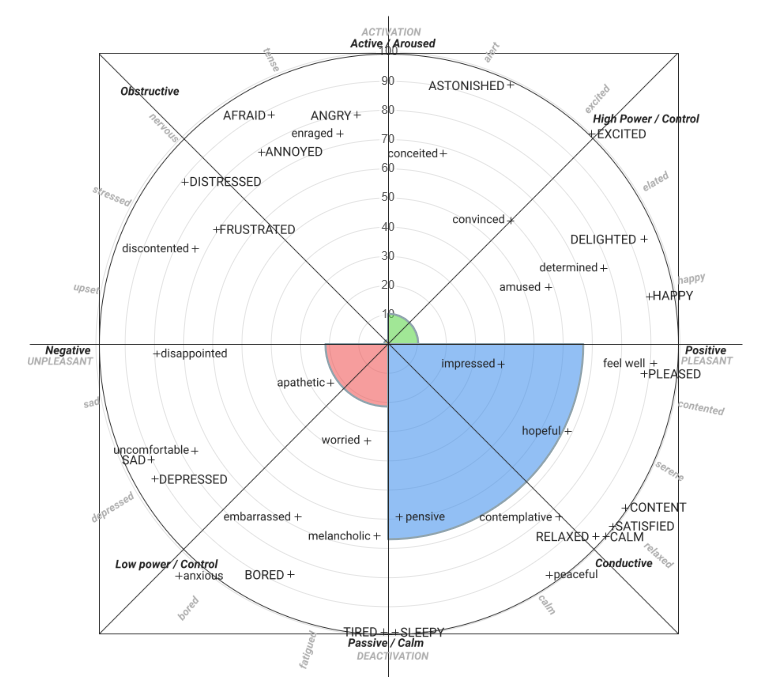In the intricate landscape of human emotions, two essential dimensions, arousal and valence, play a pivotal role in shaping our affective experiences. This blog post explores the profound insights provided by Russell’s circumplex model of affect, delving into the 2D arousal-valence quadrants and their significance in decoding human emotions.
Understanding Arousal and Valence
Arousal, as defined by Russell’s model, represents the spectrum of alertness or physiological and psychological activation in an individual. Ranging from low to high, it encompasses states of lethargy at the low end and heightened alertness or excitement at the high end. Arousal highlights the intensity of emotional experiences without categorizing them as inherently positive or negative.
On the other hand, valence addresses the intrinsic attractiveness (positive valence) or averseness (negative valence) of an event, object, or situation. Positive valence includes emotions like happiness and joy, while negative valence encompasses emotions such as sadness and fear. Valence provides insight into the desirability of the emotional state experienced by an individual.
Mapping Emotions in a 2D Circumplex Space
Russell’s circumplex model ingeniously integrates arousal and valence into a 2D space. This allows for a comprehensive mapping of a wide range of emotions. This visual and conceptual framework aids in distinguishing emotions based on their intensity and direction. For instance, excitement is characterized by high arousal and positive valence, while sadness is marked by low arousal and negative valence. This mapping not only aids academic understanding but also serves as the foundation for Emotion AI technologies.

The Role of Emotion AI
By analyzing cues indicating specific levels of arousal and valence, Emotion AI technologies can interpret human emotions with precision. This capability enables machines to respond to human needs and states in a more empathetic and nuanced manner, enhancing human-machine interactions.
Scientific Background of Emotional Concepts
The list of 98 affects provided encompasses adjectives describing emotions, feelings, and mental states. These concepts find their scientific basis in various fields, including psychology, neuroscience, sociology, and emotional intelligence.
Psychology
Psychology, as the study of mind and behavior, explores how emotions are experienced, processed, and expressed. Different theories, such as the James-Lange theory and the Cannon-Bard theory, offer explanations for the interplay of physiological reactions, cognitive assessments, and environmental interactions in emotional experiences.
Neuroscience
Neuroscience investigates the biological underpinnings of emotions by studying the brain and nervous system. Specific brain regions and neurotransmitters play significant roles in emotional processing, shedding light on the mechanisms behind emotions like fear, anxiety, and pleasure.
Sociology and Anthropology
These fields study emotions from a social and cultural perspective, acknowledging the influence of cultural norms on how emotions are expressed and perceived. While the capacity for emotion is universal, the expression and interpretation of emotions can vary across cultures.
Emotional Intelligence
Emotional intelligence emphasizes the ability to recognize, understand, manage, and use one’s own emotions positively. It has become a valuable framework in personal and professional development, highlighting the role of emotions in human interaction and decision-making.
Evolutionary Psychology
This field provides insights into the evolutionary origins of emotions, viewing them as adaptive responses to environmental challenges. Emotions like fear, love, and anger are seen as mechanisms that increased the likelihood of survival and reproductive success.
Conclusion: decoding human emotions
In conclusion, the concepts of arousal and valence, as delineated by Russell’s circumplex model, provide a structured approach to understanding the intricate world of human emotions. The 2D circumplex space not only aids academic exploration. But it also serves as a foundational model for advancing Emotion AI technologies. The scientific understanding of emotions draws from psychology, neuroscience, sociology, anthropology, and evolutionary biology, providing a multidisciplinary perspective on the complex interplay between brain, mind, body, and society in the realm of emotional experience.
What to know more about how to interpret Emotion AI generated data? Read our Guide to interpret data generated by Emotion AI.




